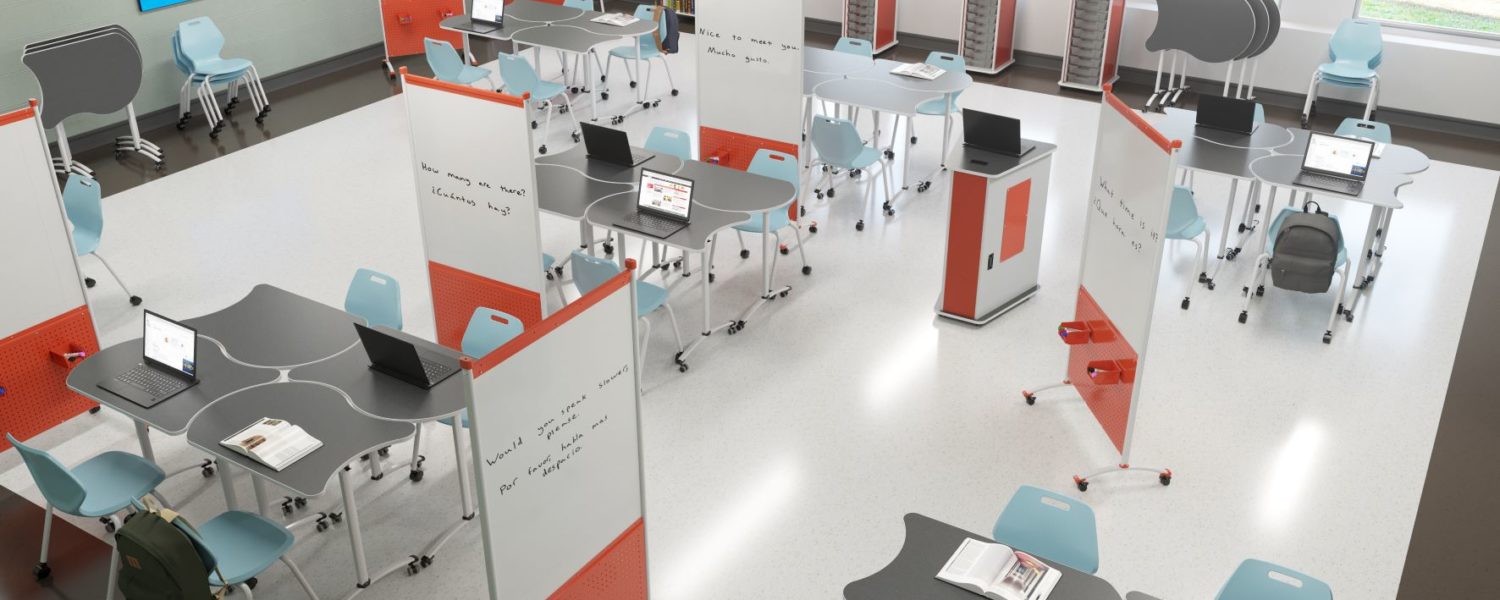By John-Paul Nelson
Schools all over the world have undergone massive changes in the last several months, and uncertainty seems to be the only constant. Temporary shutdowns that were supposed to last a few weeks turned into full-blown campus closures, and a shift to distance learning became the norm with no time to properly prepare.
Thankfully, students and educators tend to be highly adaptable, and education has pressed on despite the unusual circumstances. As schools begin to open in different and limited capacities, one issue is becoming apparent – physical learning spaces need to be agile enough to adapt to change.
Education environments have experienced various transformations over the last decade, and much of it has been centered around furniture. We have seen classrooms go from neat rows of chair-desk combos all facing the teacher up front, to fun shaped tables in grouped arrangements and various seating choices spread around the room. Collaborative, active, and hands-on learning has been at the center of classroom design, and furniture commonly seen in 21st century learning environments supports these modalities.
Research backs the positive effects of this movement, but schools are now faced with a challenge that steps directly in the path of that progress. Instead of encouraging students to work in groups and “get their hands dirty,” social distancing and regular handwashing is the mandate. Based on this new, (and hopefully short-term) reality, how can school furniture be used in a meaningful way to preserve these positive strides while keeping students & teachers safe? It’s all about flexibility.
The idea of flexible furniture in classrooms is not new, but the concept has taken on new meaning during the current crisis. Many campuses are expanding outside of the traditional four walls of a classroom and holding court in alternative places like cafeterias, gyms, outdoors, and even in hallways.
Every space has the potential to become a learning space with the right tools in place, and that’s where flexible furniture comes into play. Flexibility can mean many different things, but there are key characteristics that all furniture should encompass to fall into that category. Flexible furniture must be mobile, multipurpose, and work in concert with intentional design.
Mobility
First and foremost, desks, chairs, storage, and even shelving should have the ability to move with ease. Mobile furniture allows a room to be reconfigured on the fly – whether that means wheeling half of the furniture out of the room and into the gym or spacing students apart at the appropriate distance. When the students themselves can help rearrange the space, it gives them ownership of their environment and takes pressure off the teachers.
Simple mobility is also a huge plus when it comes to cleaning and sanitizing a room. Schools will no longer just be sweeping classrooms every other week. Extensive cleaning is becoming a daily chore, and when the furniture can be moved out of the way and back in place without the need of a dolly or multiple people, that saves much needed time and resources.
This goes beyond just being able to push a desk or chair across the room, though. Furniture with true mobility includes casters that can be used on different terrain and construction that can withstand heavy use and consistent movement.
When it comes to larger pieces, moving through doorways and across thresholds must be considered, and having a dedicated place to hold makes a big difference. Mobile furnishings with the proper rolling casters, easy-to-grip handholds, and appropriate dimensions are a huge first step toward a truly flexible classroom.
Multiple Uses
Any piece of furniture that can be used for more than one application just makes sense, whether the goal is a flexible classroom or not. If a desk can be used for individual work and seamlessly group with other desks to create a conveniently spaced breakout pod, it removes the necessity for an additional large table. It also eliminates the need to move from one classroom to the next when the activities change throughout the day.
Rolling storage carts that contain removable totes allow teachers to assign students their own personal bins that can be used at desks during the day and locked up at night. Sharing of supplies is at a minimum in classrooms right now, and containment of materials is more important than ever.
A mobile markerboard can be used for instruction or student ideation, while at the same time acting as a physical barrier that can be used to separate space. Instead of using static boards permanently attached to the wall, teachers can bring the instruction to the students, and students can brainstorm from their desks. Even a flip and nest table with a whiteboard top can be used as a workstation, writing surface, and mobile partition. Students can remain at their table with access to whiteboard space, and when not in use, the tabletops can be flipped vertically to store away or partition space without impeding the line of sight.
Many modern school furniture products are designed specifically for multiuse applications, but a little creativity can go a long way with existing classroom furniture. Every item should be used in as many ways as possible to conserve much needed space, avoid cross contamination, and create temporary zones of separation.
Providing Safe & Comfortable Space
Aside from the utilitarian reasons to use flexible furniture in learning spaces, there is another benefit that may be even more important than the practical applications. Comfort goes beyond having a plush seat or a table adjusted to the right height. True flexibility works to provide options for everyone using the space to conform with different individual needs, providing physical, as well as emotional comfort.
Given the current circumstances in education, relative comfort is taking on a whole new meaning when it comes to the classroom. We want every student and teacher to feel safe and comfortable in school so they can focus on education and not on all the obvious distractions surrounding them that are difficult to ignore. If the furniture can provide even a modicum of comfort by having flexibility designed into its purpose, it is worth much more than just saving space or being easy to move.
There are many temporary safeguards in place right now that will hopefully be history soon, but flexible furniture is one aspect of classroom design that will continue to thrive.
John-Paul Nelson is the marketing director at Paragon Furniture. Paragon’s mission is to improve the experience of students & teachers through innovative furniture design that positively impacts education, www.paragoninc.com.








